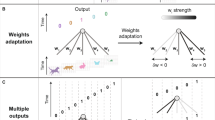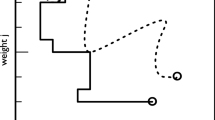Abstract
Learning processes in the brain are usually associated with plastic changes made to optimize the strength of connections between neurons. Although many details related to biophysical mechanisms of synaptic plasticity have been discovered, it is unclear how the concurrent performance of adaptive modifications in a huge number of spatial locations is organized to minimize a given objective function. Since direct experimental observation of even a relatively small subset of such changes is not feasible, computational modeling is an indispensable investigation tool for solving this problem. However, the conventional method of error back-propagation (EBP) employed for optimizing synaptic weights in artificial neural networks is not biologically plausible. This study based on computational experiments demonstrated that such optimization can be performed rather efficiently using the same general method that bacteria employ for moving closer to an attractant or away from a repellent. With regard to neural network optimization, this method consists of regulating the probability of an abrupt change in the direction of synaptic weight modification according to the temporal gradient of the objective function. Neural networks utilizing this method (regulation of modification probability, RMP) can be viewed as analogous to swimming in the multidimensional space of their parameters in the flow of biochemical agents carrying information about the optimality criterion. The efficiency of RMP is comparable to that of EBP, while RMP has several important advantages. Since the biological plausibility of RMP is beyond a reasonable doubt, the RMP concept provides a constructive framework for the experimental analysis of learning in natural neural networks.
Similar content being viewed by others
References
Albus JS (1971) A theory of cerebellar function. Math Biosci 10: 25–61
Baev KV, Shimansky YP (1992) Principles of organization of neural systems controlling automatic movements in animals. Prog Neurobiol 39: 45–112
Cauwenberghs G (1993) A fast stochastic error-descent algorithm for supervised learning and optimization. In: Advances in neural information processing systems, vol 5. Morgan Kaufman Publishers, San Mateo, CA, pp 244–251
Eisenbach M (2004) Chemotaxis. Imperial College Press, River Edge, NJ
Haydon PG (2001) Glia: listening and talking to the synapse. Nat Rev Neurosci 2: 186–193
Houk JC, Buckingham JT, Barto AG (1996) Models of the cerebellum and motor learning. Behav Brain Sci 19: 368–383
Ito M (1984) The cerebellum and neural control. Raven Press, New York
Kargo WJ, Nitz DA (2004) Improvements in the signal-to-noise ratio of motor cortex cells distinguish early versus late phases of motor skill learning. J Neurosci 24: 5560–5569
Kirkpatrick S, Gerlatt CD Jr, Vecchi MP (1983) Optimization by simulated annealing. Science 220: 671–680
Lamprecht R, LeDoux J (2004) Structural plasticity and memory. Nat Rev Neurosci 5: 45–54
Macnab RM, Koshland DE Jr (1972) The gradient-sensing mechanism in bacterial chemotaxis. Proc Natl Acad Sci USA 69: 2509–2512
Marr DJ (1969) A theory of cerebellar cortex. J Physiol (Lond) 202: 437–470
Mazzoni P, Andersen RA, Jordan MI (1991) A more biologically plausible learning rule for neural networks. Proc Natl Acad Sci USA 88: 4433–4437
Rumelhart DE, Hinton GE, Williams RJ (1986) Learning internal representations by error propagation. In: Rumelhart DE, McClelland JL (eds) Parallel distributed processing: explorations in the microstructure of cognition, vol 1: Foundations.. MIT Press, Cambridge, MA, pp 318–362
Shimansky YP (2007) Role of optimization in simple and learning-based adaptation and its biologically plausible mechanisms. In: Williams TO (eds) Biological cybernetics research trends. Nova Science Publishers, Hauppauge, NY
Shimansky YP, Kang T, He J (2004) A novel model of motor learning capable of developing an optimal movement control law online from scratch. Biol Cybern 90: 133–145
Werbos PJ (1974) Beyond regression: new tools for prediction and analysis in the behavioral sciences. Ph.D. dissertation, Committee on Applied Mathematics, Harvard University, Cambridge, MA
Werfel J, Xie X, Seung HS (2004) Learning curves for stochastic gradient descent in linear feedforward networks. In: Thrun S, Saul L, Scholkopf B (eds) Advances in neural information processing systems, vol 16. MIT Press, Cambridge, MA
Author information
Authors and Affiliations
Corresponding author
Rights and permissions
About this article
Cite this article
Shimansky, Y.P. Biologically plausible learning in neural networks: a lesson from bacterial chemotaxis. Biol Cybern 101, 379–385 (2009). https://doi.org/10.1007/s00422-009-0341-6
Received:
Accepted:
Published:
Issue Date:
DOI: https://doi.org/10.1007/s00422-009-0341-6




